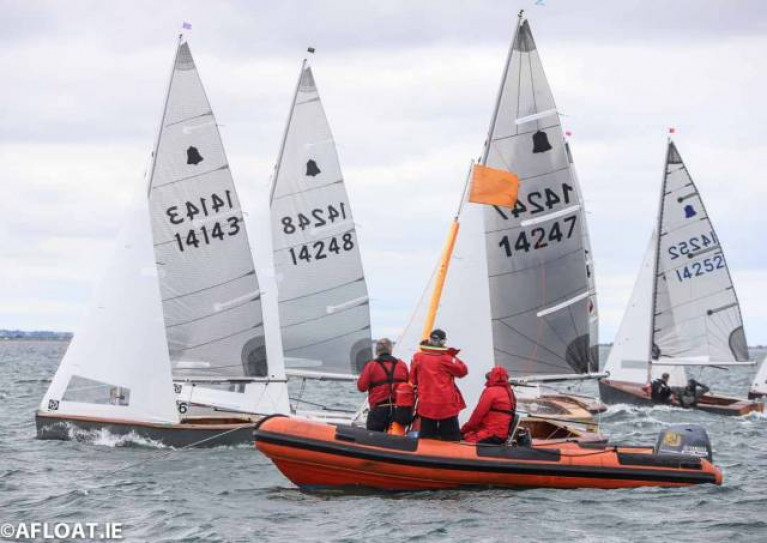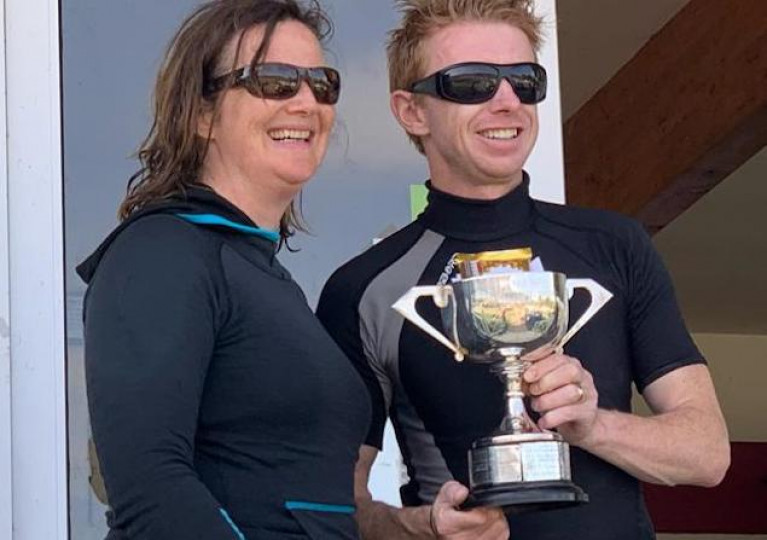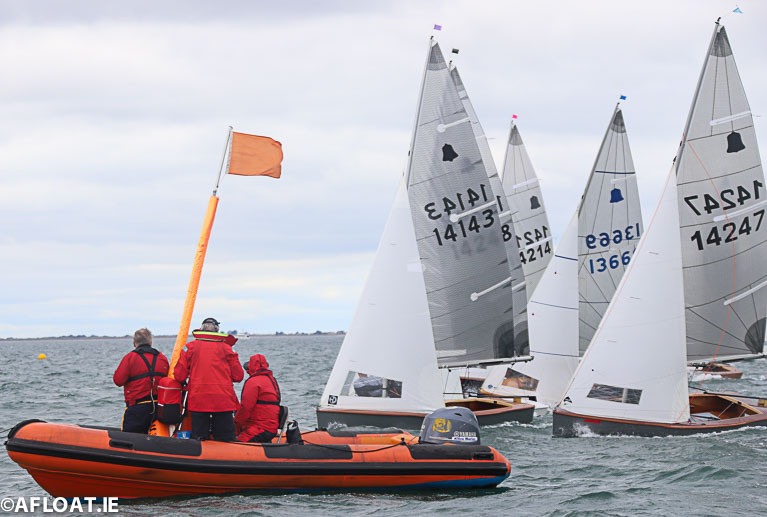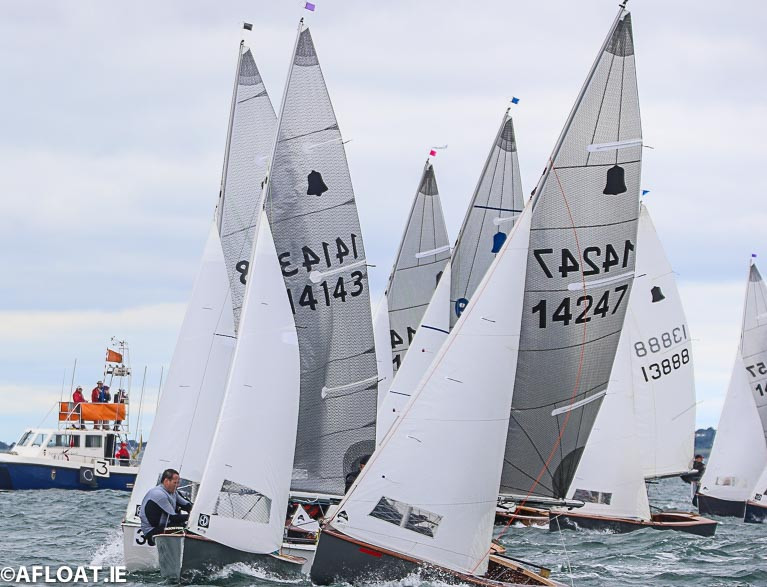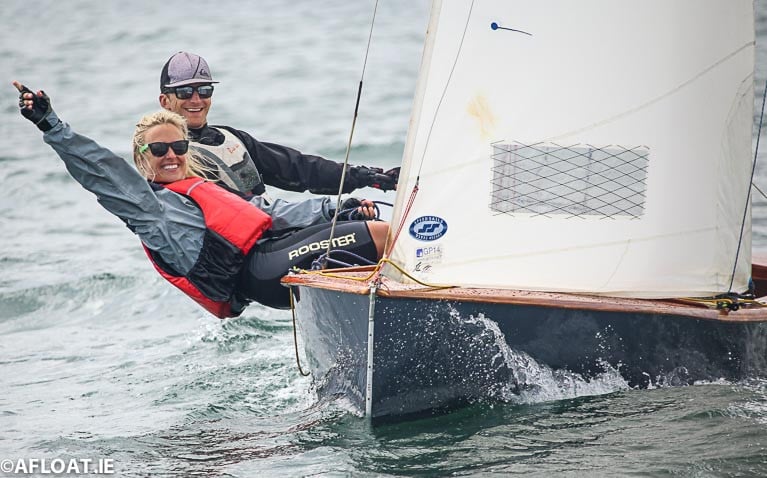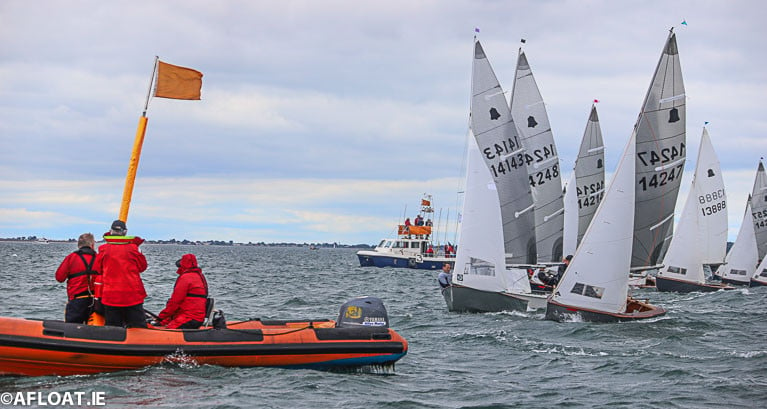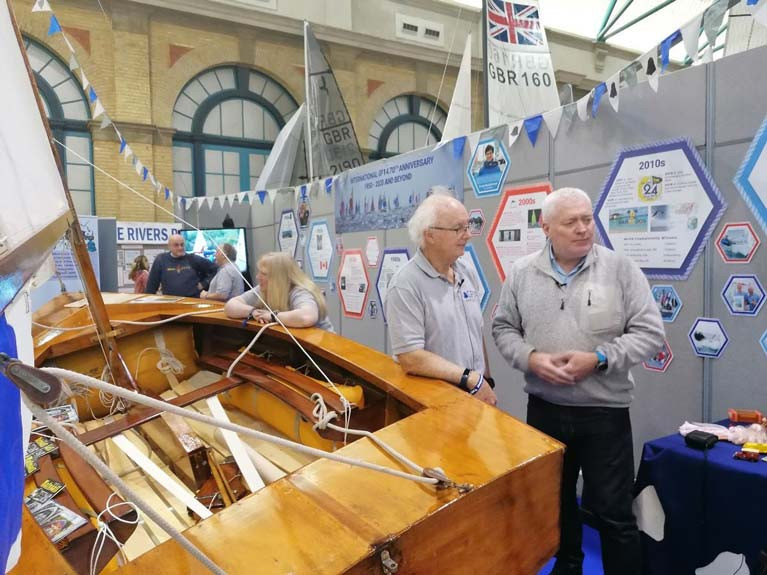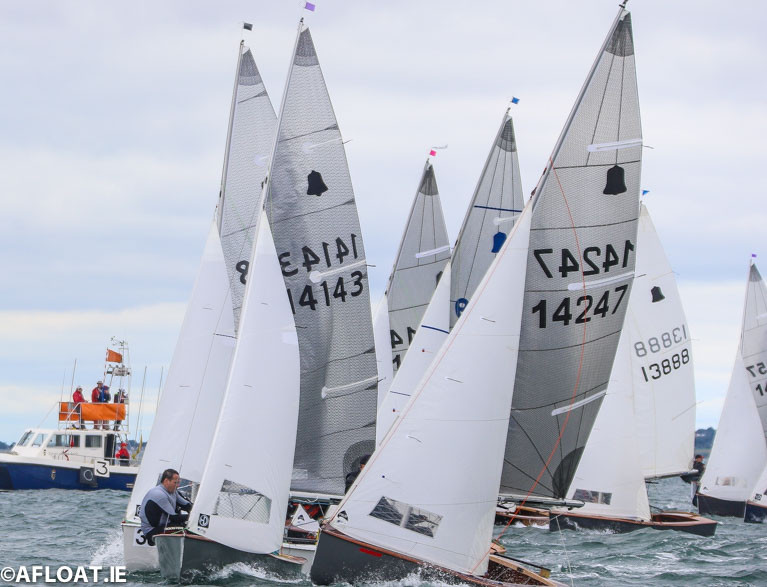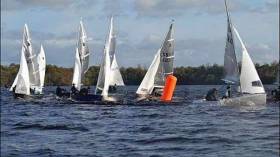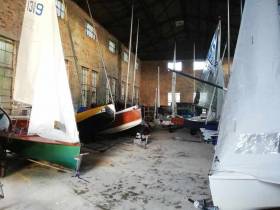Displaying items by tag: GP14
GP14s Give Thumbs up to Volvo Dun Laoghaire Regatta 2021 Dinghy Plans
The Irish GP14 dinghy class has been one of the first to give a thumbs up to Volvo Dun Laoghaire Regatta plans for next July to divide Ireland's biggest sailing event over separate weekends.
As Afloat reported previously, Dun Laoghaire organisers plan to major on the dinghies and one design keelboats with a One Design Championship from 2nd – 4th July 2021 and then run the cruiser-racers the following weekend (8th – 11th July) catering for a full range of IRC classes.
After a year of cancellations that wiped out nearly the entire GP14 2020 calendar, including the Skerries-based World Championships in August, the GP14 Committee has been supportive of Dun Laoghaire's move to the Dinghy/One Design event.
If all goes to plan the Geeps will be just one of many dinghy classes racing at VDLR next July before the restaging of its own class world championships in Skerries later that same month (July 25 to Aug 1 2021).
The only Irish GP14 event to sail so far this year was held in Blessington earlier this month as Afloat reported here.
The committee says there is still hope, notwithstanding the Dublin and Donegal Level 3 lockdowns, that the annual 'Hot Toddy' event can still go ahead in East Antrim in Larne on October 10th.
Royal Irish Yacht Club's Ger Owens & Mel Morris are GP14 Autumn Open Winners
Royal Irish Yacht Club's Ger Owens & Mel Morris were the winners of the 20-boat GP14 Autumn Open at Blessington Sailing Club last weekend, the first event of the 2020 GP14 calendar due to COVID-19.
The winner of the silver fleet was Ed Coyne & Colman Grimes (Youghal & Skerries). Bronze winners were Edie & Lily Thorup (Blessington)
The event doubled as the youth championships and the winners here were:
- Youth Championship (U22) – Ed Coyne & Colman Grimes (Youghal & Skerries)
- U19 Champion – Peter Boyle & Shane McLoughlin / Joe Doherty (Sutton Dinghy Club)
- U16 Champion – Max Cully & Ollie Lloyd (Blessington)

GP14s Aim for East Antrim's Hot Toddy Event
An appropriate title for a GP 14 event to be held (hopefully) in October at the Larne club. The word toddy comes from the toddy drink in India produced by fermenting the sap of palm trees and its earliest known use to mean "a beverage made of alcoholic liquor with hot water, sugar, and spices", is from 1786. The latter will be just the thing to warm up sailors taking part in this widely anticipated meeting.
As entries aren't open yet for the event on 10th/11th October, and no one is confirmed but the Club hopes to have at least some of the following well known GP14 stalwarts competing: the host club's Curly Morris and Robert Gingles, with crews as yet unknown and Ger Owens and Melanie Morris, daughter of Curly.
Committee member Lucy Whitford says that " It would be great to see the former world champion and multiple National champions Shane McCarthy, and Ross and Jane Kearney, former Irish champions who have recently moved back to NI. Welcome too would be regulars on the GP circuit John and Donal McGuiness, Hugh Gill, Colman Grimes, Katie Dwyer and Michelle Rowley, and Bill and James Johnson. We would also hope to see some up and coming youth GP sailors competing, Peter Boyle, David Johnson and Conor Twohig".
 The late Ronnie Thompson, with Andy Thompson. Andy is to team up with Shane McCarthy for this event.
The late Ronnie Thompson, with Andy Thompson. Andy is to team up with Shane McCarthy for this event.
East Antrim has a long list and long history of champion GP14 sailors. Johnny McWilliam was among the first to shine when he won the 1957 Northern Ireland championship, with Curly Morris and Tommy Hutcheson taking the same title in 1964 followed the next year by Paul Rowan and Graham Gingles. Jump forward a few years to 1972 and we have Tom Jobling crewing for Ballyholme's Peter Duffy winning the Irish Championship and Des Nixon and Tommy Hutcheson NI Champions; Curly Morris and Bobby Jones Ulster Champions with Curly also on the Irish Olympic Team in Kiel. Into this century among other GP 14 helms to feature prominently are Mark and Paul Fekkes.
This Hot Toddy event first saw the light of day in the early eighties when the then GP14 Assoc of Ireland charged their East Antrim BC based fleet with the creation of a new and suitable end-of-season 'fun' event.
With the baton accepted a team lead by the legendry helmsman Curly Morris set to work and devised a new kind of 'freestyle' format to take advantage of what Larne Lough could offer.
So in October 1982, the mighty GP14 fleet descended on the Larne Lough club to be greeted with a perfect sparkling south easterly. A single windward leg from EABC into the [uncharted] upper Lough! Thereafter the fleet re-assembled for a spinnaker slalom in a freshened breeze, back from whence they came and, ashore for the evening festivities.
The event was superbly serviced with prizes by the 'shop-keepers' of the town and sponsored overall by the coal importer, Howdens Ltd, who also provided the solid silver winner's cup. And it looks like the first winner will be in the frey again for that was Curly Morris. That day as well as the cup, he received a 'bag of coal' to fend off the incoming Co. Antrim winter. Hopefully, a Hot Toddy will do the same!
The GP14 International Class Association in conjunction with Skerries Sailing Club has postponed its 2020 GP14 World Championships until 2021.
As Afloat reported previously, with over 100 entries already registered, Skerries Sailing Club and the GP14 International Association have been in discussion for quite some time preparing for this eventuality.
In announcing the postponement have provisionally pencilled in July 25 to Aug 1 2021 as the new date for the GP14 World Championships to be held in Skerries.
Ferry Refunds
Currently, the UK Government restrictions on travel for non-essential journeys are in place until 31st May 2020. As the World Championship was scheduled for July 2020, there is currently some uncertainty with regards to the refund option for non-refundable tickets purchased by UK competitors. If the Government extends the ban on non-essential travel to include the dates the hope is refunds should be available.
A further update on the status of the GP14 World Championships scheduled for July in Skerries, North Dublin is expected before the end of April.
GP14 Ireland Hon. Secretary Andy Johnston has told the class the International Committee in conjunction with the Skerries GP14 Worlds Organising Committee is in 'constant communications' with regard to the running of the World Championships and the threat posed by COVID-19 to the successful staging of the event.
As Afloat previously reported, more than 100 boats have now entered for the Championships at Skerries Sailing Club from July 24-29.
Johnston also advises the sailors that 'it is with regret but no surprise' that the Munsters at Cullaun Sailing Club and the Leinsters at (Mullingar Sailing Club) ear-marked for the weekends of May 2/3 and May 23/24 respectively have been postponed.
Depending on the COVID-19 situation, the Clubs would hope that one or both may be run at a later date this summer.
With travel restrictions in place across Ireland and the UK, all GP14 coaching dates have also been cancelled.
More than 100 boats have now entered for the GP14 dinghy World Championships at Skerries Sailing Club scheduled from July 24-29.
The International GP14 Committee in conjunction with the Skerries SC Worlds Organising Committee says it is in 'constant communication over the Covid-19 emergency'. The championships is building 'very well' for a top event both on and off the water, according to event chairman Colman Grimes.
There is no surprise, however, that the GP14 O'Tiarnaigh Challenge to be held in Howth Yacht Club on April 4/5 has fallen victim of the Covid-19 precautions.
Open events at the north Dublin club scheduled up to the end of April have all been cancelled.
GP14 coaching events scheduled up to the end of April have also been cancelled.
To mark the 70th anniversary of the GP14 Class there will be a Classic fleet event within the overall World Championships in Skerries, County Dublin this summer.
The recently restored GP14 Number 2 took pride of place at last weekend's RYA Dinghy Show in London.
The vintage boat will be across in Skerries for the 2020 World Championships and will be on the water in the hands of Sutton sailing legend Pat Murphy and Michael Easton.
GP14 O'Tiarnaigh Challenge Set for Howth Yacht Club on April 4/5
The GP14 dinghy season kicks off in Howth Yacht Club on April 4/5 with a revised format O’Tiarnaigh Challenge.
The GP14 Committee are anticipating a big turnout for a couple of reasons.
Firstly, its an opportunity to for an early start to preparations for the GP14 World Championships at Skerries in July. With the Ulster Championships (Newtownards) the only other event being held on the sea before the Skerries Worlds in July, the Committee has agreed that this year's O'Tiarnaigh will be run as a standard GP14 event rather than the usual separated fleets, flights and sail-offs.
Secondly, it also marks the 20th anniversary of the passing of GP14 sailor Riocaird O’Tiarnaigh for whom the event honours. O'Tiarnaigh was a huge presence in the fleet both as a sailor (Sutton Dinghy Club) as well as an administrator (President of both GP14 International Class & GP14 Ireland Class as well as Hon. Secretary of the Irish Sailing Association).
McCarthy & Owens Win GP14 'Hot Toddy' End of Season Event on Lough Erne
The final GP14 meeting of the season, the “Hot Toddy” took place on 19/20 October in the beautiful setting at Lough Erne Yacht Club writes Katie Dwyer.
As Afloat previously reported, conscious of the interest in the rugby world cup quarter-final, organisers delayed the Saturday start to 13:30 with a big screen in the club for sailors to watch Ireland v New Zealand. Sadly, the rugby result was not in our favour, but spirits weren’t dampened, and sailors eagerly took to the water. With 33 boats, it was the largest turnout of the year.
Lough Erne delivered some very challenging yet enjoyable sailing conditions over the two days. The wind ranged from 5- 20 knots and was shifty throughout with no distinct patterns. As a result, all sailors were kept on their toes with positions consistently changing throughout the races. Race Officer Mickey McCaldin and his team ran a full series of six races over the two days, and kept things moving promptly to avoid too much downtime for the sailors in the chilly October breeze.
"Lough Erne delivered some very challenging yet enjoyable sailing conditions over the two days"
Well deserved “Hot Toddies” were enjoyed by sailors on returning ashore, followed by an evening of food, fun and frolics at the yacht club which was very well attended.
Overnight leaders with three race wins and showing an enviable level of boat speed were Shane McCarthy (GSC) and his very capable substitute crew, Ger Owens. Sligo Yacht Clubs Niall Henry and Ossian Geraghty were in second, with Lough Foyle Yacht Clubs Gareth Gallagher and Ollie Goodhead in third and also leading the silver fleet. Blessington Sailing Club's Sam Street led the bronze fleet.
We took to the water on Sunday for an earlier than usual start for Race 4 at 10:30. The breeze was up and as shifty as the previous day. Shane and Ger won race 4 and 5 and with the event win in the bag, headed for shore. It provided an opportunity for a new race winner which was duly taken by Youghal Sailing Clubs Adrian Lee and Richard Street who had a comfortable lead throughout the race.
Winners of the Hot Toddy were Shane McCarthy and Ger Owens, with five race wins. Over the six races, second and third places were shared across eight different boats, demonstrating the high level of competition in the fleet. With Shane and Ger clear winners, it was down to consistency and how discards came into play to determine the results within the chasing pack. Finishing in second were Niall Henry and Ossian Geraghty, with Sutton Dinghy Club Katie Dwyer and Michelle Rowley in third.
Winners of the silver fleet were Garreth Gallagher and Ollie Goodhead, finishing a solid fourth overall. In second place, Adrian Lee and Richard Street, followed by Blessingtons Simon Cully and Libby Tierney in third.
Top two in the bronze fleet were Blessingtons Sailing Clubs Sam Street and Tiarnan Brown, followed by Matthew Street and Rhian O’Hiblin in second with Mullingar Sailing Clubs Michael Collender and Brian Walker in third.
A special thanks must go to LEYC JP and Carolyn McCaldin and all the volunteers, who organised and ran a super event. It was also JP and Carolyns’ last outing in a GP for a while, with Brendan Brogan stepping in to take up the front seat with JP in 2020.
The fleet will return to Lough Erne in July 2020 for the Irish Nationals, which will be the last event before the Worlds in Skerries.
Download results below
GP14 Aces Team Up For Lough Erne 'Hot Toddy'
The last event of the GP14 calendar saw the fleet returning to Lough Erne Yacht Club this weekend. And what a fleet. 33 boats turned up on the start line for what is turning into a great event.
While Dublin hid from the rain and the cold wind yesterday, the lake was basked in some beautiful sunshine and a challenging 5 to 20-knot breeze. But the fleet had 3 great races with another 3 today.
Shane MacCarthy found an unusual crew today with Ger Owens stepping to the crew slot at the last minute. His own crew Mel Morris was unavailable. 3 races wins ensued but behind them there was some close racing. On their first event and race back this season, Katie Dwyer & Michelle Rowley from Sutton Dinghy Club took a 2nd and finished the day in 5th of 33. In second going into today's racing is Niall Henry & Oisin Geraghty (Sligo) with Gareth Gallagher in 3rd. Local event organisers JP & Carolyn McCaldin lie in 4th.
The event is also the final event in the GP14 Leagues with some place still to play for. A great turnout for the event will also improve what are very encouraging figures over the season. Average numbers each event have held up and across the season there have been 65+ different helms take part. 20 each in Gold & Silver and 25 in Bronze which includes a good sprinkling of Youth. Let hope today's sees some more great sailing conditions. The end augurs well for next season with the GP14 World's coming to Skerries next July.


























